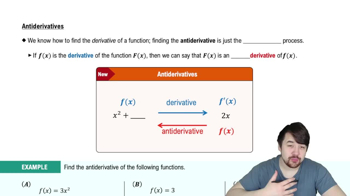Suppose the graph of a continuous function is shown below, and the area between the graph of and the -axis from to is (above the -axis), and from to is (below the -axis). What is the value of the definite integral ?
Table of contents
- 0. Functions7h 54m
- Introduction to Functions16m
- Piecewise Functions10m
- Properties of Functions9m
- Common Functions1h 8m
- Transformations5m
- Combining Functions27m
- Exponent rules32m
- Exponential Functions28m
- Logarithmic Functions24m
- Properties of Logarithms36m
- Exponential & Logarithmic Equations35m
- Introduction to Trigonometric Functions38m
- Graphs of Trigonometric Functions44m
- Trigonometric Identities47m
- Inverse Trigonometric Functions48m
- 1. Limits and Continuity2h 2m
- 2. Intro to Derivatives1h 33m
- 3. Techniques of Differentiation3h 18m
- 4. Applications of Derivatives2h 38m
- 5. Graphical Applications of Derivatives6h 2m
- 6. Derivatives of Inverse, Exponential, & Logarithmic Functions2h 37m
- 7. Antiderivatives & Indefinite Integrals1h 26m
- 8. Definite Integrals4h 44m
- 9. Graphical Applications of Integrals2h 27m
- 10. Physics Applications of Integrals 3h 16m
- 11. Integrals of Inverse, Exponential, & Logarithmic Functions2h 34m
- 12. Techniques of Integration7h 41m
- 13. Intro to Differential Equations2h 55m
- 14. Sequences & Series5h 36m
- 15. Power Series2h 19m
- 16. Parametric Equations & Polar Coordinates7h 58m
8. Definite Integrals
Fundamental Theorem of Calculus
Problem 5.3.43
Textbook Question
Definite integrals Evaluate the following integrals using the Fundamental Theorem of Calculus
∫₋₂⁻¹ 𝓍⁻³ d𝓍
 Verified step by step guidance
Verified step by step guidance1
Step 1: Recall the Fundamental Theorem of Calculus, which states that if a function f(x) is continuous on [a, b] and F(x) is its antiderivative, then ∫ₐᵇ f(x) dx = F(b) - F(a).
Step 2: Identify the integrand, which is x⁻³ (or 1/x³). The goal is to find its antiderivative. Rewrite the integrand as x⁻³ for clarity.
Step 3: Compute the antiderivative of x⁻³. Using the power rule for integration, ∫xⁿ dx = (xⁿ⁺¹)/(n+1) + C, where n ≠ -1. For x⁻³, n = -3, so the antiderivative becomes -1/(2x²).
Step 4: Apply the limits of integration, -2 and -1, to the antiderivative. Substitute x = -1 and x = -2 into the antiderivative expression, F(x) = -1/(2x²).
Step 5: Calculate the difference F(-1) - F(-2) to evaluate the definite integral. This step involves substituting the values and simplifying the result.
 Verified video answer for a similar problem:
Verified video answer for a similar problem:This video solution was recommended by our tutors as helpful for the problem above
Video duration:
2mPlay a video:
Was this helpful?
Key Concepts
Here are the essential concepts you must grasp in order to answer the question correctly.
Definite Integrals
Definite integrals represent the signed area under a curve between two specified limits on the x-axis. They are denoted as ∫[a, b] f(x) dx, where 'a' and 'b' are the lower and upper limits, respectively. The value of a definite integral provides a numerical result that quantifies the accumulation of quantities, such as area, over the interval [a, b].
Recommended video:

Definition of the Definite Integral
Fundamental Theorem of Calculus
The Fundamental Theorem of Calculus links the concept of differentiation with integration, stating that if F is an antiderivative of f on an interval [a, b], then ∫[a, b] f(x) dx = F(b) - F(a). This theorem allows us to evaluate definite integrals by finding the antiderivative of the integrand and calculating its values at the limits of integration.
Recommended video:

Fundamental Theorem of Calculus Part 1
Antiderivatives
An antiderivative of a function f(x) is another function F(x) such that F'(x) = f(x). Finding an antiderivative is essential for evaluating definite integrals using the Fundamental Theorem of Calculus. For example, if f(x) = x^n, the antiderivative is F(x) = (x^(n+1))/(n+1) + C, where C is a constant. Understanding how to find antiderivatives is crucial for solving integral problems.
Recommended video:

Antiderivatives

 6:11m
6:11mWatch next
Master Fundamental Theorem of Calculus Part 1 with a bite sized video explanation from Patrick
Start learningRelated Videos
Related Practice
Multiple Choice
14
views
